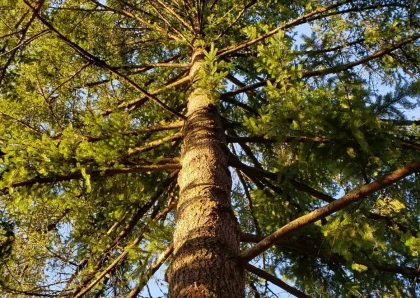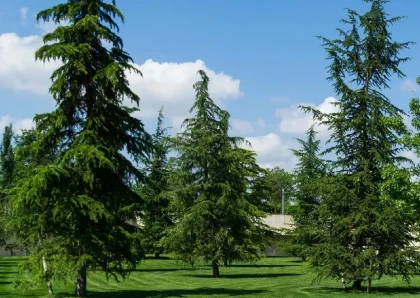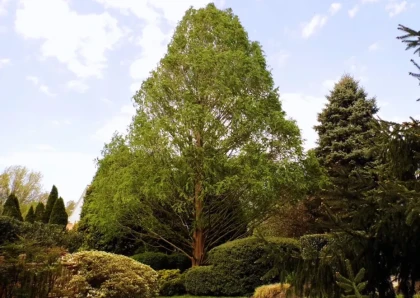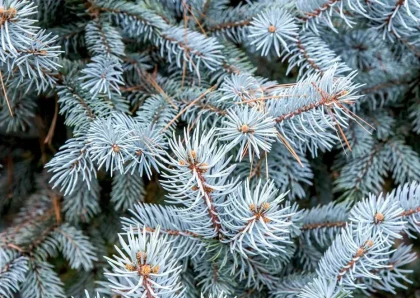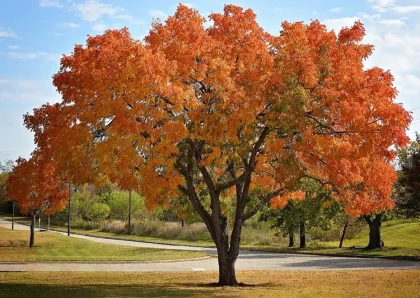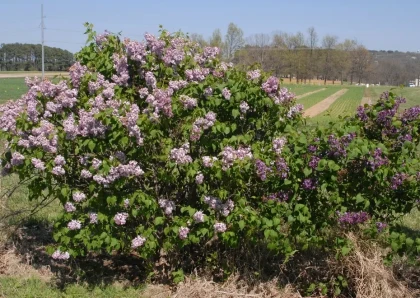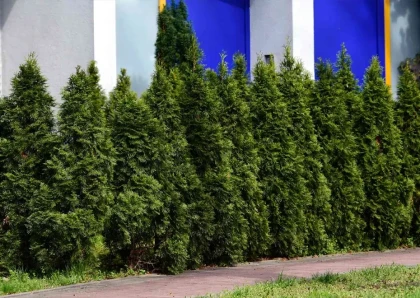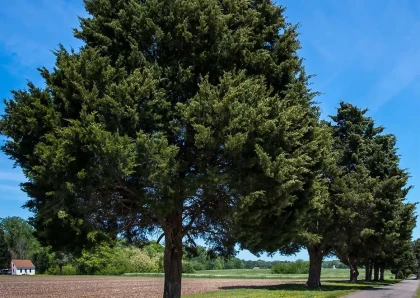
European Beech Tree
Overview
The European Beech (Fagus sylvatica) is a deciduous tree species native to much of Europe, including parts of western Asia. It is one of the most common and widespread trees in the region, known for its impressive size, smooth gray bark, and distinctively shaped leaves.
Here are some key characteristics of the European Beech tree:
- Appearance: The European Beech is a large tree that can grow up to 30-45 meters (98-148 feet) tall. It has a rounded crown with dense, dark green foliage that turns a beautiful golden brown in the autumn.
- Leaves: The leaves of the European Beech are simple, alternate, and have a unique elliptical shape with wavy edges and prominent parallel veins. They are typically 5-10 cm (2-4 inches) long and arranged in a way that allows sunlight to pass through the canopy, creating dappled shade on the forest floor.
- Reproductive structures: The tree produces small inconspicuous flowers in the spring. Male flowers are borne on long catkins, while female flowers are found in pairs. The fruit is a triangular nut enclosed in a prickly husk called a cupule. These nuts are an important food source for various wildlife.
- Longevity: European Beech trees are known for their longevity, often living for several centuries. Some ancient specimens can even be over 500 years old.
- Habitat: European Beech trees are highly adaptable and can thrive in a variety of soil types, though they prefer well-drained, fertile soils. They are commonly found in mixed deciduous forests alongside other tree species like oak, maple, and ash.
- Ecological importance: The European Beech tree plays a vital role in many ecosystems. It provides habitat and food for numerous animals and insects. Its nuts are consumed by birds and small mammals, while its dense foliage provides shelter for various wildlife species.
- Cultural significance: The European Beech has cultural importance in Europe and has been used for various purposes by humans for centuries. Historically, beech wood has been used in carpentry, furniture making, and as firewood. Additionally, beech forests have served as popular recreational areas for hiking and other outdoor activities.
Types of European Beech Trees
- Fagus sylvatica 'Pendula' (Weeping European Beech): This variety is known for its graceful weeping branches, which give it a unique and attractive appearance. It is often used as an ornamental tree in parks and gardens.
- Fagus sylvatica 'Purpurea' (Purple European Beech): This cultivar has deep purple or burgundy-colored leaves, adding a touch of rich color to landscapes. The leaves turn bronze in the fall.
- Fagus sylvatica 'Asplenifolia' (Fern-leaf European Beech): This variety has deeply cut, fern-like leaves, which give it a delicate and lacy appearance.
- Fagus sylvatica 'Dawyck' (Dawyck European Beech): This cultivar is notable for its narrow columnar shape, making it an excellent choice for smaller spaces or avenues.
- Fagus sylvatica 'Riversii' (Rivers Purple European Beech): Similar to 'Purpurea', this cultivar has purple leaves, but the color may vary, ranging from purple-red to copper-red.
- Fagus sylvatica 'Rotundifolia' (Round-leaved European Beech): This variety has rounder leaves compared to the typical European Beech, but it still retains the characteristic beech leaf shape.
- Fagus sylvatica 'Zlatia' (Golden European Beech): This cultivar has golden-yellow leaves in the spring, which gradually turn greenish-yellow as the summer progresses.
- Fagus sylvatica 'Tortuosa' (Tortuosa European Beech): This variety is known for its twisted and contorted branches, giving it a unique and interesting appearance.
Wood Products from European Beech Trees
- Furniture: European Beech wood is a popular choice for furniture making. Its light color, smooth texture, and fine grain make it suitable for creating elegant and durable pieces. It is commonly used for chairs, tables, cabinets, and other indoor furniture.
- Flooring: Beech wood is often used for hardwood flooring. Its hardness and resistance to wear make it a practical and attractive flooring option for both residential and commercial spaces.
- Interior Millwork: European Beech is used for various interior millwork applications, including trim, moldings, wainscoting, and paneling. Its uniform appearance and ease of machining make it ideal for these purposes.
- Toys and Turned Objects: The light color and smooth surface of Beech wood make it suitable for crafting toys, kitchen utensils, and other turned objects like bowls, vases, and candlesticks.
- Veneer: European Beech is used to produce veneer sheets, which are thin slices of wood used to cover furniture, cabinets, and other surfaces. Beech veneer offers an attractive, uniform appearance.
- Plywood: Beech plywood is made by gluing several layers of beech veneer together. It is commonly used in construction and for making furniture where strength and stability are required.
- Musical Instruments: Some musical instruments, particularly stringed instruments like guitars and violins, use European Beech wood for certain components due to its tonal properties.
- Carpentry and Joinery: European Beech wood is a popular choice for general carpentry and joinery work. It is used for various structural and decorative elements in building construction.
- Wooden Utensils: Due to its non-toxic properties, Beech wood is used for crafting kitchen utensils, cutting boards, and other culinary tools.
- Packaging: Beech wood is occasionally used for crafting wooden boxes, crates, and pallets due to its strength and durability.
Benefits of European Beech Tree
- Ecological Importance: European Beech trees play a vital role in forest ecosystems. They provide habitat and food for numerous animals, including birds, mammals, and insects. The nuts produced by the tree are an essential food source for wildlife.
- Carbon Sequestration: Like all trees, European Beech trees absorb carbon dioxide from the atmosphere and store it as carbon in their biomass. This process helps mitigate the effects of climate change by reducing greenhouse gas levels in the atmosphere.
- Soil Improvement: Beech trees have a deep root system that helps improve soil structure and fertility. The leaf litter they shed contributes to the nutrient cycle and enriches the forest floor.
- Timber Production: European Beech wood is highly valued for its quality and versatility. It is used in various woodworking applications, including furniture making, flooring, millwork, and veneer production.
- Hardwood Firewood: Beech wood is a popular choice for firewood due to its high density and slow-burning properties, providing an efficient source of heat during the colder months.
- Landscaping and Shade: European Beech trees are often planted in parks, gardens, and urban areas for their aesthetic value. They provide shade and create pleasant green spaces for recreation.
- Longevity and Stability: European Beech trees are known for their longevity, with some specimens living for several centuries. Their sturdy growth and resistance to wind make them stable and reliable in landscapes.
- Erosion Control: The extensive root system of European Beech trees helps prevent soil erosion on slopes and hillsides, contributing to landscape stability.
- Wildlife Conservation: As a native tree species, European Beech plays a role in conserving regional biodiversity by providing essential habitat for various plant and animal species.
- Cultural and Historical Significance: Beech forests have cultural significance in many European countries. They have been an integral part of folklore, local traditions, and historical land use practices.
- Beech Nuts for Human Consumption: Beech nuts are edible and have been historically used as a food source for human consumption in some cultures.
- Medical Uses: In traditional medicine, different parts of the European Beech tree have been used for various purposes, including treating wounds and skin conditions.
Tips for planting and maintaining European Beech Tree
- Site Selection: Choose a planting site with well-drained soil and adequate sunlight. European Beech trees prefer moist, fertile soils but can tolerate a range of soil types. Avoid areas with waterlogged or compacted soil.
- Planting Time: The best time to plant European Beech trees is during the dormant season, typically in the fall or early spring. This allows the tree to establish its root system before the hot summer or cold winter.
- Planting Depth: When planting the tree, make sure the root ball is level with the soil surface or slightly above it. Avoid planting too deep, as this can lead to root suffocation and poor growth.
- Mulching: Apply a layer of organic mulch around the base of the tree (but not directly against the trunk) to retain moisture, suppress weeds, and regulate soil temperature.
- Watering: Newly planted European Beech trees require regular watering to help them establish their roots. Water deeply but less frequently to encourage deep root growth. As the tree matures, it becomes more drought-tolerant.
- Pruning: European Beech trees generally require minimal pruning. Remove any dead or damaged branches and shape the tree as needed to maintain its form and structure.
- Fertilization: In nutrient-poor soils, you may consider fertilizing the tree during the growing season. However, be careful not to over-fertilize, as this can lead to excessive foliage growth at the expense of root development.
- Protection from Pests and Diseases: Monitor the tree regularly for signs of pests or diseases. If detected, take appropriate measures to control the issue promptly.
- Staking: While European Beech trees are generally sturdy, young trees may benefit from staking to provide support during their early years of growth.
- Winter Protection: In colder climates, protect young trees from frost or extreme winter conditions with a layer of mulch or burlap wraps.
- Leave Room for Growth: European Beech trees can grow quite large, so make sure to plant them with enough space to accommodate their mature size without crowding other trees or structures.
- Regular Inspection: Periodically inspect the tree for signs of stress or potential issues. Address any problems early to maintain the tree's health and longevity.
Cons of planting European Beech Tree
- Disease Susceptibility: European Beech trees are vulnerable to certain diseases, such as beech bark disease and beech leaf disease. These diseases can cause significant damage to the trees, leading to decline and death in severe cases.
- Pest Infestations: Like many other tree species, European Beech trees can be affected by various pests, including beech scale insects and aphids. These pests can weaken the tree and make it more susceptible to other health issues.
- Shallow Root System: European Beech trees have shallow root systems, which can make them less stable during severe weather events like storms or heavy winds. It also limits their ability to access water and nutrients during drought conditions.
- Competition with Other Plants: European Beech trees are known to have dense foliage, which can create heavy shade beneath the canopy. This can inhibit the growth of understory plants and reduce biodiversity in the area.
- Allelopathy: Beech trees produce allelopathic chemicals that can inhibit the growth of other plant species around them. This can further reduce the diversity of plants in the immediate vicinity of the tree.
- Slow Growth: European Beech trees are generally slow-growing, especially when compared to some other tree species. It may take several years or even decades for them to reach their full size and maturity.
- Nutrient Demand: Beech trees require nutrient-rich soils to thrive. In nutrient-poor soils, they may struggle to grow and develop properly, leading to poor health and growth.
- Leaf Litter: Beech trees shed a substantial amount of leaves during the fall season. While this leaf litter can enrich the soil, it can also create maintenance challenges, such as clogged gutters and potential slip hazards on walkways.
- Invasive Potential: In certain regions outside its native range, European Beech has the potential to become invasive and outcompete native species, disrupting local ecosystems.
- Allergenic Pollen: Some people may be sensitive or allergic to beech tree pollen, leading to respiratory issues and discomfort during the flowering season.
Conclusion
The European Beech tree (Fagus sylvatica) is a majestic and iconic deciduous tree native to much of Europe. It has been valued for its ornamental beauty, dense shade, and useful wood for centuries. However, like any tree species, there are both positive and negative aspects to consider. Here's a balanced conclusion about the European Beech tree:
Positive Aspects
- Ornamental Beauty: European Beech trees are prized for their attractive, smooth grey bark, and vibrant green foliage during the growing season. In the fall, their leaves turn into beautiful shades of yellow, orange, and copper, enhancing the landscape's visual appeal.
- Shade and Landscaping: Due to their broad canopy and dense foliage, European Beech trees provide excellent shade, making them ideal for parks, gardens, and residential areas where people seek relief from the sun.
- Tolerant of Various Soils: European Beech trees can adapt to various soil types, although they prefer well-drained, moist, and fertile soils. This adaptability makes them suitable for a wide range of planting locations.
- Wildlife Habitat: The dense foliage of European Beech trees provides shelter and nesting sites for various wildlife species, including birds and small mammals. They also serve as a food source for birds and other animals that feed on their nuts.
- Longevity: European Beech trees can live for several hundred years, making them a long-lasting addition to the landscape when properly cared for.
Negative Aspects
- Disease and Pest Susceptibility: European Beech trees are susceptible to diseases such as beech bark disease and beech leaf disease, as well as infestations from various pests like scale insects and aphids. These issues can negatively impact the tree's health and aesthetics.
- Shallow Root System: The shallow root system of European Beech trees makes them less stable during severe weather conditions, potentially leading to uprooting or damage during storms.
- Maintenance Challenges: The dense foliage of European Beech trees can lead to significant leaf litter during the fall season, requiring regular maintenance to keep outdoor areas clean.
- Allelopathy: The allelopathic chemicals released by European Beech trees can inhibit the growth of other plants in their vicinity, potentially reducing plant diversity in the area.
FAQs
1. What is the scientific name of the European Beech tree?
The scientific name of the European Beech tree is Fagus sylvatica.
2. Where is the European Beech tree native to?
The European Beech tree is native to much of Europe.
3. What are the positive aspects of planting European Beech trees?
- Ornamental Beauty: European Beech trees are prized for their attractive, smooth grey bark, and vibrant green foliage during the growing season.
- Shade and Landscaping: Due to their broad canopy and dense foliage, European Beech trees provide excellent shade, making them ideal for parks, gardens, and residential areas.
- Tolerant of Various Soils: European Beech trees can adapt to various soil types, making them suitable for a wide range of planting locations.
- Wildlife Habitat: The dense foliage of European Beech trees provides shelter and nesting sites for various wildlife species.
- Longevity: European Beech trees can live for several hundred years.
4. What are the negative aspects of planting European Beech trees?
- Disease and Pest Susceptibility: European Beech trees are susceptible to diseases and infestations from various pests.
- Shallow Root System: The shallow root system of European Beech trees can make them less stable during severe weather conditions.
- Maintenance Challenges: The dense foliage of European Beech trees can lead to significant leaf litter during the fall season.
- Allelopathy: European Beech trees release allelopathic chemicals that can inhibit the growth of other plants in their vicinity.
5. When is the best time to plant European Beech trees?
The best time to plant European Beech trees is during the dormant season, typically in the fall or early spring.
6. How can I care for newly planted European Beech trees?
Newly planted European Beech trees require regular watering to help them establish their roots. Water deeply but less frequently to encourage deep root growth. Provide a layer of organic mulch around the base of the tree (but not directly against the trunk) to retain moisture and regulate soil temperature.
7. Are European Beech trees drought-tolerant?
As the tree matures, it becomes more drought-tolerant. However, newly planted trees will require consistent watering to establish their roots.
8. How large do European Beech trees grow?
European Beech trees can grow quite large, with mature specimens reaching heights of 50 to 80 feet and having a spread of 40 to 60 feet.




